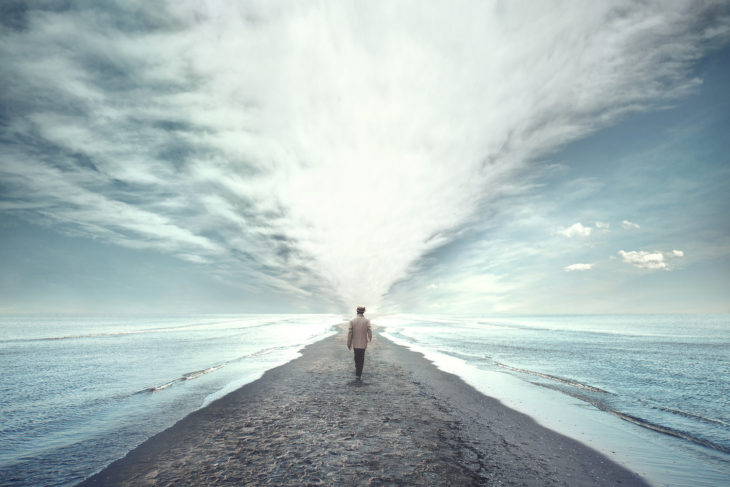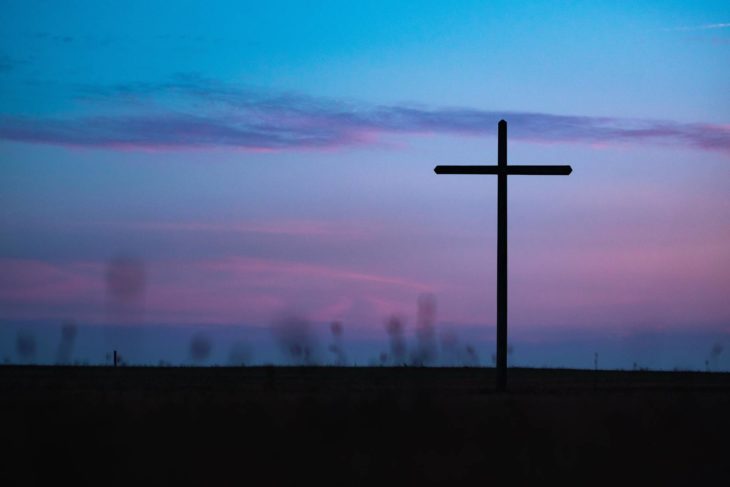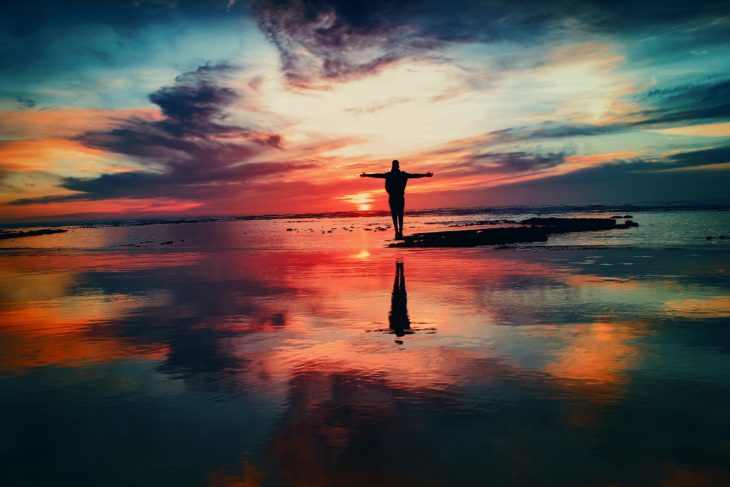Faith in humanity is the only faith I have. As in, I don’t have faith in a god or anything particularly spiritual. I’m not going to waffle over that and say that there’s a possibility that a god, in fact, does exist, or that I could be wrong. I am certain that I’m not wrong. I will, however, say that it takes the same kind of faith for me to say that I know I’m not wrong that it takes for other people to say that they know for sure that a god does exist. In a smuch as that’s the case, I acknowledge the possibility that other people’s gods exist for them as purely, simply, and undeniably as there is no god for me.
I grew up Catholic, which is to say, I grew up not attending church but leaning nonetheless on the idea that there was some sort of “higher power.” My mother lost, if not her faith exactly, then most of the structure and trappings of her faith when she went to visit the graveyard of our ancestors, the Veteri Ponte, in Normandy, when I was a junior in high school. She said she got to the graveyard, and it was this tiny little graveyard in Caen. All the headstones were covered with moss, and worn away, so that it was hard to even see the name, Veteri Ponte. And she stayed there for a while, and a question arose: Is this all there is? Is this how we end up?
There’s this long, ancient line of ancestors she’d spent months tracing through centuries of text and documents. We’re lucky that we can even do that — the Veteri Ponte were barons, one of them was Queen Elizabeth I’s handmaid, and her husband was the Queen’s champion (the knight who fought on her behalf in tournaments). We have documentation of our lineage, which most people don’t. Not that aristocracy made a lot of difference for us, ultimately — the Catholic Veteri Ponte were stripped of their titles and restored to them over and over because of the conflicts between the Catholic Church and the Church of England, and ultimately they migrated to Canada, and then the United States. My grandfather was a grocery store manager, and my mom’s family, by then the Viponds, had a different kind of good life than the Veteri Ponte barons.
I think it was easy for her, in researching our history, to look at our ancestors and build characters out of them. The handmaid, for example, had a smart mouth and talked back to the Virgin Queen. (That’s a trait that’s been passed down, apparently.) But when she finally got there, she wasn’t confronted with stories and characters, she was confronted with eroding headstones, covered with moss, pretty much forgotten. I think it made the present very, very real to her. I think it made her feel like everything can and will fade away, like nothing sticks, like the lives we have right now are the only thing that matters.

Source: bobyandian
That was a pretty stupendous blow to me, and really pretty shocking, because it was my mom who dragged us to church, my mom who was disappointed when I refused to get confirmed (I wasn’t sure that I was Christian and if God existed, I didn’t want to lie to him), my mom who, after her mother died, had wanted to wrap herself in her parents’ faith and started attending services more regularly. It made me sad. I didn’t understand why she seemed to be so OK with it.
Then, almost 10 years later, the same thing happened to me, but in a drastically different way. From the age of 18 until I was 25, I was in a relationship with my ex, who was abusive, who manipulated me emotionally, who was passive-aggressive sometimes and then at other times full-out aggressive-aggressive, who threatened me into, well, a lot of things. Abusive relationships are built on promises and justifications. I believed the explanations he had for me, and the accusations, and the promises that he intentionally, knowingly, failed to live up to — and I make that distinction because everyone fails to live up to their promises, but it’s abusers who do it knowing that they’re making those promises merely to keep their victim around.
I leaned on the Bible. Luke 12 told me not to worry: That if I place my hurt and anger and worry on God, that God would take care of it. That if I just had faith, God would provide the things I needed. That God knew what was in my best interest, and He would provide me no more and no less. So for those seven years, I put my hurt and pain and anger and worry on God instead of my ex-boyfriend/fiancé/husband and let things slide while he leeched my time, opportunities, money, education, and sanity.
It’s no small wonder that at some point I started having some very real questions about the inconsistencies in the Bible, the justification of “You’re just supposed to believe it, it’s a leap of faith.” I felt like, if I was going to put all my pain on God and trust Him while I continued to hurt, I wanted to know exactly how it all worked. More and more, it wasn’t even that the Christian faith didn’t make logical sense to me — that would be fine, as there are some things that can’t be explained by concrete reality, like love — but that it didn’t even make imaginative sense to me. As in, I didn’t understand how the faithful were using their imaginative faculties to create a scenario in which something as central to the faith as the Holy Trinity actually made sense (I won’t get into it — it’d take longer and be potentially offensive).

Source: juneauempire
But then I realized that that precipice of faith — that moment when you’re standing at the edge of your faith and looking down into a chasm — was where the faithful were willing to take a step out into nothingness, “Indiana Jones and the Last Crusade”-style, and I could not. The faithful would say, “You just have to have faith and believe the things you don’t understand,” and put their foot down on thin air and be able to walk across to the other side. I wanted the sand that Indy threw across the chasm to mark where he had to step. I could not believe without evidence. That, essentially, is the definition of an atheist.
*****
It was about this time that I started studying the artwork Untitled (Portrait of Ross in L.A.) by Felix Gonzalez-Torres. It’s a 175-pound pile of candy, housed usually at the Art Institute of Chicago, comprised of a confection called Fruit Flashers — hard, fruit-flavored candies in multi-colored metallic plastic wrappers. It signifies the body of Felix’s partner, Ross, or rather is his body. It’s 175 pounds because that was Ross’s weight when he was healthy. Both Felix and Ross died of AIDS — Ross in 1991, and Felix in 1996. The viewer is meant to take a piece of the candy, and by the viewers taking the candy, Ross’s body deteriorates, mimicking the process of his death.
Critics said that this artwork was about death. I came to a different conclusion: The museum has to refill the pile to 175 pounds, technically but definitely not always every day. So the body deteriorates and grows again, which isn’t the process of death at all — it’s the same process as trees shedding leaves and regrowing them, skin cells dying and sloughing off and new cells growing in their place, or a star exploding, eating its planets, blasting those particles into space, and those particles being sucked together by gravity to form new stars and new planets and new solar systems. It’s the process of life, and in creating this artwork, Felix granted Ross an indefinite life. It’s the most beautiful eulogy I’ve ever seen written in any medium.
When I originally approached the piece, I thought it was sacramental, that it was Eucharistic (the Eucharist being communion, or “that wafers and wine thing”). I thought that it was Felix putting Ross in the place of Christ, venerating him — but it wasn’t. No matter how much I thought I could prove it was, it just wasn’t. The biggest obstacle to that conclusion was the fact that Gonzalez-Torres was so ardent and outspoken an atheist that his intentions were hard to ignore; it was hard merely to let the viewer’s interpretation of the piece — mine, in this case — take precedence over the goals he tried to accomplish through his artwork.

Source: juneauempire
Specifically, there was this passage from an interview he did with Tim Rollins:
“I have a major problem with the cultural traps and constructions of God. I think that it is a good excuse for us to accept any kind of situation as natural, inevitable. Once we believe that there is no God, that there is no afterlife, then life becomes a very positive statement. It becomes a very political position because, then, we have no choice but to work harder to make this place the best place ever. There is only one chance, and this is it. If you fuck it up this time, you’ve fucked up forever and ever. Therefore, God becomes a kind of lollipop you give people: ‘Look, you are suffering now in this life. I’m making you feel and live miserably. I’m making things really horrible for you, but in the next life things will be better. […]
Once you agree that there is not any other life, there’s nothing except here — this thing, this table, you, me — that’s it. That becomes a very radical idea because you have to take responsibility to make it the best.”
And that’s why he made art.
I remember sitting on the floor of the apartment I shared with my ex-husband, looking through note cards I’d hand-written with quotes from journal articles, biographies, catalogs and interviews, all spread around me in a corona, and thinking about this passage. It wasn’t like a light bulb popping on over my head, more like a dimmer fading the light on slowly, when the idea sank in to my head that the God I had so desperately clung on to as a coping mechanism was not actually providing for me the way Luke told me He would, that the things I could not understand about Christian faith were simply irreconcilable in my system of belief. That there is a world that has explanations for many, many things, and that I live in it already, and that the things that don’t have explanations — like coincidence, or love, or even religious faith — can be understood by the same human imaginative faculty that makes it so that something as simple as a piece of hard candy in a metallic wrapper can not just stand for but actually be the cycle of life in the universe, and a deep and awesome physical manifestation of love and grief.
In that moment, I was granted the sand to throw across the abyss and walk to the other side of the chasm, in the form of hard candies. I found faith in humanity, and specifically, in the human imagination, which is bigger, wider, and deeper than anything I’ve ever heard of, the whole universe included. And I understood why my mother had been all right with that loss of faith: In that moment, in which she looked at those headstones and realized that one day she would be dirt and there were no guarantees past that, she realized that this was her life, and she had to guide it where she wanted it to go the very best she could. Needless to say, I think, I left my ex-husband just a few weeks after that.
*****
Back to today: It’s been a bad few weeks, few months. When I started writing professionally, I had no idea what kind of stress that could induce, that reactions to it could be so profoundly upsetting that it would trigger my PTSD, that I would end up spending days mired in heartbreaking tweets about kids getting killed and women being raped and, on the other hand, tweets from people whose psyches are so seemingly decrepit that they can justify and defend the idea of killing kids or raping women, if not actually doing it. It’s not the entire job, of course: I have the privilege of writing about butter and getting a pat on the back for it. But it’s the part of the job I care about the most, and it’s easy to look at humanity and just throw your hands up and say there is no hope. For every person in the world who wants to provide other people with equal access to shelter, food, economic opportunities, social influence, political influence, and basic safety, there’s someone else who believes that not everyone deserves equal access to those things, and usually they believe that it’s people who are already marginalized and hurt (think women, people of color, people in minority religious groups in any particular region, gays, trans* people, people who are not conventionally abled, and the poor) who don’t deserve those things.

Source: earth
Clergy — Christian and otherwise — have always played an active role in civil and human rights struggles. In the Christian faith, that’s ostensibly because Christ was not, in fact, in favor of bolstering the rights of the rich; because Christ did not, in fact, scorn women; because Christ did not, in fact, ever say that one race was greater than another. (There were problematic things that Christ did say, but the clergy who engage in civil rights struggles tend not to engage with those, thankfully.) And then there’s the spectre of Gandhi hanging over any civil rights movement, a man who was religiously ascetic, whose religious asceticism drew him to nonviolence and espousing vehement political beliefs through his faith.
I can join them as a secularist, or an atheist, inasmuch as I believe that if the human imagination is big enough to manifest such huge concepts as undying love and indefinite life through a piece of hard candy — Think about that! It’s just a piece of candy, but it expands far, far out into the universe through our ability to imagine things — it’s also possible to make manifest ideals like equality, compassion, love, kinship, and justice. It’s hard to manifest those things in a physical, concrete reality, but it is possible. If this is all we have, if this is the only life we’re ever going to live, if this is the only world that exists and it’s got problems, it is our responsibility to fix them. It is our responsibility to live as manifestations of equality, compassion, love, kinship, and justice. It’s our responsibility to make those ideals physically manifest.
Now. Today.
Original by:
